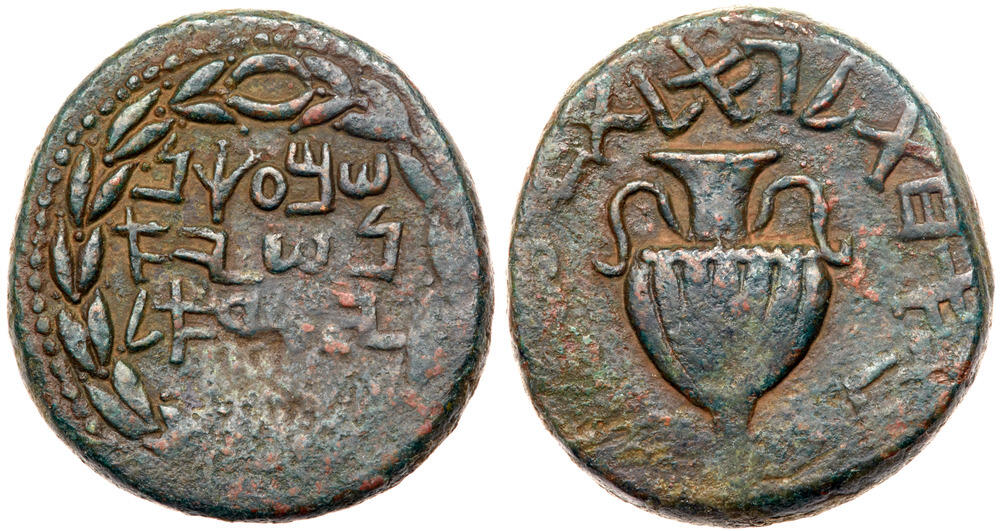Judaea (uncertain mint) (Bar Kokhba), large bronze (inscription/amphora) (132-133 CE)
From SILVER
132 CE - 133 CE Bronze
Description
| ObverseInscription or printing placed on the obverse.: | 'Simon, Prince of Israel' (Paleo-Hebrew).'Simon, Prince of Israel' within wreath |
| ReverseInscription or printing placed on the reverse.: | 'Year one of the redemption of Israel' (Paleo-Hebrew).Amphora with two handles |
Mint and issuing power
| MintIdentifies the place of manufacture or issue of a numismatic object.: | Judaea (uncertain mint) | Ancient regionAncient region.: | Judaea | Modern countryModern country: Israel | AuthorityIdentifies the issuing power. The authority can be "pretended" when the name or the portrait of X is on the coin but he/she was not the issuing power. It can also be "uncertain" when there is no mention of X on the coin but he/she was the issuing power according to the historical sources: | Simon bar Kokhba (military leader and king of Judea, 132-135 CE) |
Chronology
| FromIdentifies the initial date in a range assigned in a numismatic context. | 132 CE | toIdentifies the final date in a range assigned in a numismatic context.. | 133 CE | PeriodTime period of the numismatic object.: Roman from 30 BC |
Physical description
| MetalThe physical material (usually metal) from which an object is made.: | Bronze |
Median weightMedian of the weights of numismatic objects (in grams). in grams | 24.00 | DenominationTerm indicating the value of a numismatic object. Examples: tetradrachm, chalkous, denarius.: | StandardStandard.: |
Image

Bar Kokhba bronze inscription amphora.jpg [1]
References
| Die study referencePublication of the study: | Mildenberg 19841Mildenberg 1984, p. 294-301 | ||
| Coin series referenceReference to coin series study: | |||
Obverse dies distribution
| FrequencyFrequency of specimen in distribution. ᵖ | Number of obversesNumber of obverse dies. ᵖ (o) | % (o) | Number of coinsNumber of coins. (n) | % (n) | Die nameName(s) of the die(s). |
| 1 | 1 | 16.67 | 1 | 0.68 | 4 |
| 11 | 1 | 16.67 | 11 | 7.43 | 6 |
| 15 | 1 | 16.67 | 15 | 10.14 | 5 |
| 21 | 1 | 16.67 | 21 | 14.19 | 3 |
| 44 | 1 | 16.67 | 44 | 29.73 | 2 |
| 56 | 1 | 16.67 | 56 | 37.84 | 1 |
| Total | 6 of 6 | 100.02 | 148 of 148 | 100.01 |
Reverse dies distribution
no distribution is available
Quantification
| Number of obversesNumber of obverse dies. ᵖ (o) | 6 | Number of singletons (o1)The number of singleton coins. ᵖ | 1 |
| Number of reverse diesNumber of reverse dies. (r) | 12 | Number of coinsNumber of coins. (n) | 148 |
| Coins per obverse dieNumber of coins per obverse die. (n/o) | 24.67 | Coins per reverse dieNumber of coins per reverse die. (n/r) | 12.33 |
| Reverse per obverse ratioRatio of obverse dies divided by reverse dies. (r/o) | 2 | Percentage of singletons (o1)number of coins (n) divided by the number of singletons (o1) ᵖ | 16.67 % |
| Original number of dies (O) (Carter 1983 formula)The estimation of the number of coins according to Carter 1983 ᵖ | 5.8 | Coins struck if 20,000 as average productivity per dieCoins made if the average productivity for obverses (according to Carter) is 20,000. ᵖ | 116,000 |
| Original number of dies (O) (Esty 2011 formula)The estimation of the number of coins according to the singleton formula in Esty 2011 ᵖ (O) | 6.25 | Survival rate if 20,000 as average productivity per dieSurvival rate if average productivity is 20,000. ᵖ | 0.00128 |
| Coverage (o = % of O) (Esty 1984 formula)Esty 1984 - coverage (% of O) ᵖ (o = % of O) | 99.32% | Die productivity if survival rate 1/2,000Average productivity if survival rate is 1/2,000. ᵖ | 51,034.48 |
| Weight of silver (in kg) if 20,000 coins per die (O = Carter formula)Carter 1983 * Median weight * 20000 (*10 if gold or electrum) ᵖ | n.a. | Die productivity if survival rate 1/5,000Average productivity if survival rate is 1/5,000. ᵖ | 127,586.21 |
Remarks
Most likely one single workstation Certainly military
References
- ^ Mildenberg, Leo (1984), The Coinage of the Bar Kokhba War, Typos VI, Aarau, Verlag Sauerländer, 396 p.